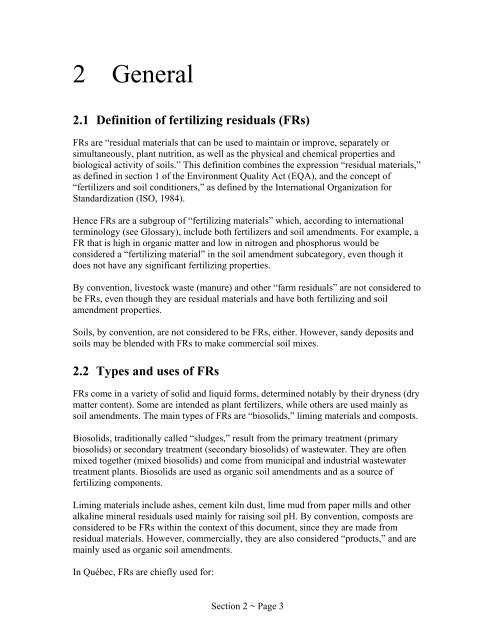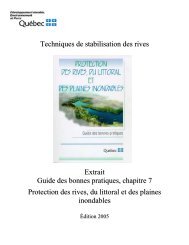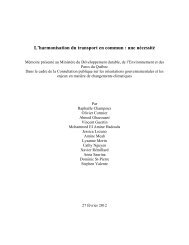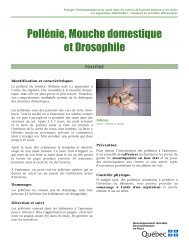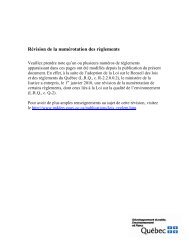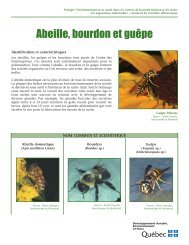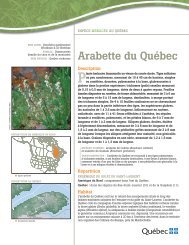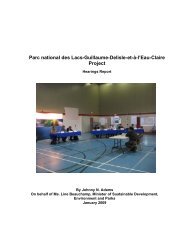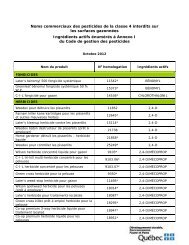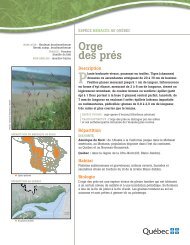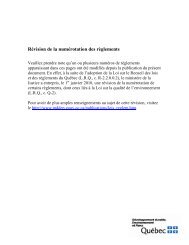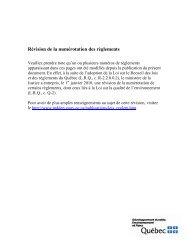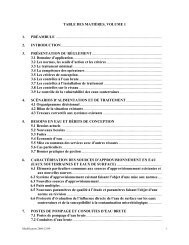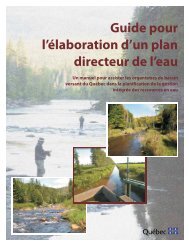Guidelines for the Beneficial Use of Fertilizing Residuals
Guidelines for the Beneficial Use of Fertilizing Residuals
Guidelines for the Beneficial Use of Fertilizing Residuals
You also want an ePaper? Increase the reach of your titles
YUMPU automatically turns print PDFs into web optimized ePapers that Google loves.
2 General<br />
2.1 Definition <strong>of</strong> fertilizing residuals (FRs)<br />
FRs are “residual materials that can be used to maintain or improve, separately or<br />
simultaneously, plant nutrition, as well as <strong>the</strong> physical and chemical properties and<br />
biological activity <strong>of</strong> soils.” This definition combines <strong>the</strong> expression “residual materials,”<br />
as defined in section 1 <strong>of</strong> <strong>the</strong> Environment Quality Act (EQA), and <strong>the</strong> concept <strong>of</strong><br />
“fertilizers and soil conditioners,” as defined by <strong>the</strong> International Organization <strong>for</strong><br />
Standardization (ISO, 1984).<br />
Hence FRs are a subgroup <strong>of</strong> “fertilizing materials” which, according to international<br />
terminology (see Glossary), include both fertilizers and soil amendments. For example, a<br />
FR that is high in organic matter and low in nitrogen and phosphorus would be<br />
considered a “fertilizing material” in <strong>the</strong> soil amendment subcategory, even though it<br />
does not have any significant fertilizing properties.<br />
By convention, livestock waste (manure) and o<strong>the</strong>r “farm residuals” are not considered to<br />
be FRs, even though <strong>the</strong>y are residual materials and have both fertilizing and soil<br />
amendment properties.<br />
Soils, by convention, are not considered to be FRs, ei<strong>the</strong>r. However, sandy deposits and<br />
soils may be blended with FRs to make commercial soil mixes.<br />
2.2 Types and uses <strong>of</strong> FRs<br />
FRs come in a variety <strong>of</strong> solid and liquid <strong>for</strong>ms, determined notably by <strong>the</strong>ir dryness (dry<br />
matter content). Some are intended as plant fertilizers, while o<strong>the</strong>rs are used mainly as<br />
soil amendments. The main types <strong>of</strong> FRs are “biosolids,” liming materials and composts.<br />
Biosolids, traditionally called “sludges,” result from <strong>the</strong> primary treatment (primary<br />
biosolids) or secondary treatment (secondary biosolids) <strong>of</strong> wastewater. They are <strong>of</strong>ten<br />
mixed toge<strong>the</strong>r (mixed biosolids) and come from municipal and industrial wastewater<br />
treatment plants. Biosolids are used as organic soil amendments and as a source <strong>of</strong><br />
fertilizing components.<br />
Liming materials include ashes, cement kiln dust, lime mud from paper mills and o<strong>the</strong>r<br />
alkaline mineral residuals used mainly <strong>for</strong> raising soil pH. By convention, composts are<br />
considered to be FRs within <strong>the</strong> context <strong>of</strong> this document, since <strong>the</strong>y are made from<br />
residual materials. However, commercially, <strong>the</strong>y are also considered “products,” and are<br />
mainly used as organic soil amendments.<br />
In Québec, FRs are chiefly used <strong>for</strong>:<br />
Section 2 ~ Page 3


